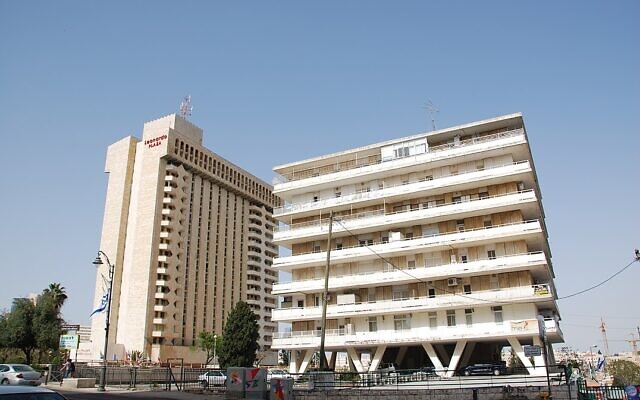Modernist eyesore from 1960s, a city landmark on King George Street, to be taken down later this year; 30-story residential building to be built on site

Eleven years after the approval process started, the Amir Center in Jerusalem, a building dubbed “the ugliest” in the city, is set for demolition later this year.
Also known as “the Shufersal Building,” the seven-story structure stands on the corner of Agron Street, facing King George Street and Paris Square. It is also famous for housing Jerusalem’s first supermarket (Hebrew link).
The plot was purchased by the Settlement Training company in 1944, when it was part of the Arab-Christian neighborhood of El Amira. The building that stands there today was designed by the Israeli-Brazilian architect David Resnick relatively early in his career, in 1958, as part of a complex of three nine-story buildings along King George Street. The other two buildings were eventually shelved, and the Planning and Building Commission turned down the proposal for nine stories, insisting on seven since the Chief Rabbinate was opposed to any building standing taller than Heichal Shlomo on the other side of King George.
The building, completed in 1961, integrated prefabricated building parts into standard construction, thereby allowing an entire floor to be finished in a day. A specialist crane was imported from Sweden to help, and in 1963 the construction team was awarded the Kaplan Prize for technological innovations.
The front of the building faces King George Street, its modern style jarring with its surroundings. Art curator Sophia Caspi Dekel described it as drawing on influences from Le Corbusier and from the Seagram Building in New York which was designed by Ludwig Mies Van der Rohe.
The building rests on V-shaped pillars intended to open up the ground floor and offer a view from King George Street to the Old City. There are four internal courtyards that deliver heating and ventilation to what were the luxury apartments of their day — 150 square meters in size, with three or four rooms, two bathrooms, and a 40-square meter living room.
Over time, the condition of the building deteriorated, despite its position in central Jerusalem, next door to what is now the Leonardo Plaza Hotel. Balconies have been closed in or converted into storerooms, and external air conditioning units have been added.
Resnick himself came to view the building as a neglected “child” — albeit one that played a major part in developing his career and worldwide reputation, leading to further commissions for him in Jerusalem. He told (Hebrew link) Haaretz in 2005 that “the building really was revolutionary but from the beginning there was something unsuccessful about it, gloomy… now it looks awful. You don’t neglect a child, even if they are unsuccessful.”
He later told (Hebrew link) the publication in 2011: “It hurts me a lot because this building is famous all over the world because of its innovation. As I pass there today I turn my head to the other side of the road. I cannot stand what they did to it.”
Moves to demolish the building began in 2011 and Jerusalem’s Municipal Conservation Committee has now given its final approval for evacuation and demolition plans (Pinui V’Binui).
The Amir Center will be replaced with a 30-story residential building housing luxury apartments.
The committee chair, Jerusalem Deputy Mayor Elisha Peleg, told local Hebrew-language news website Mynet that “the new tower will improve the visibility of the street and integrate with the massive construction expected along the revitalized King George axis. It will also add many residential units in the city center.”

